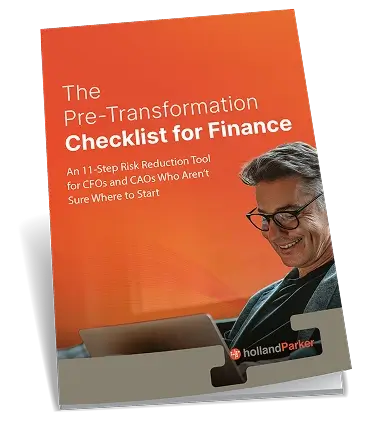In today’s finance landscape, compliance with Sarbanes-Oxley (SOX) and Internal Control over Financial Reporting (ICFR) remains a top priority for executives and audit committees. Yet manual control testing, fragmented documentation, and legacy systems create inefficiencies that heighten the risk of deficiencies during year-end audits. HollandParker, a trusted advisor in finance transformation, emphasizes that organizations moving to cloud-first finance environments have a unique opportunity to automate SOX and ICFR processes—reducing audit costs, ensuring readiness, and strengthening overall compliance posture.
Cloud-enabled finance systems provide real-time visibility and integrated workflows that are not possible in manual, spreadsheet-driven environments. By embedding automation directly into control processes, finance teams can reduce human error, streamline audit evidence collection, and focus resources on higher-value compliance oversight. For risk and compliance officers, this means shifting from reactive remediation to proactive control assurance.
This article examines four key aspects of automating SOX/ICFR in a cloud-first finance environment: embedding controls in digital workflows, leveraging continuous monitoring, reducing audit risk through automation, and aligning compliance with broader finance transformation.
Embedding Controls in Cloud-Based Digital Workflows
One of the greatest advantages of cloud finance platforms is the ability to embed controls directly into day-to-day processes. Instead of relying on periodic manual checks, automated workflows enforce compliance at the transaction level.
Examples include:
- Automated approval hierarchies for journal entries and vendor payments.
- System-enforced segregation of duties that prevents unauthorized access or dual-role conflicts.
- Real-time reconciliations that flag discrepancies immediately rather than at month-end.
HollandParker has worked with organizations where embedding controls into ERP workflows reduced manual testing requirements by nearly 40%. By eliminating paper trails and spreadsheet trackers, finance teams also simplify evidence collection for auditors.
Leveraging Continuous Monitoring for ICFR Assurance
Continuous monitoring tools in cloud environments allow finance leaders to track compliance in real time. Rather than relying on quarterly reviews or year-end testing, automated analytics identify control failures as they occur.
Key capabilities include:
- Exception reporting dashboards that highlight anomalies across transactions.
- Automated audit logs that capture evidence without manual intervention.
- Machine learning algorithms that detect unusual patterns, such as duplicate payments or revenue recognition errors.
For compliance officers, this means a stronger assurance model where risks are identified and remediated before auditors arrive. Continuous monitoring also reduces the cost of audit adjustments, which can otherwise strain both resources and reputation.
Reducing Audit Risk Through Automation
Audit readiness is one of the most pressing concerns for SOX and ICFR programs. Manual processes often result in incomplete documentation, inconsistent control testing, and rushed remediation before filing deadlines. Automation addresses these risks directly.
By standardizing workflows, cloud finance systems create consistent, repeatable control environments. Automated testing reduces variability in evidence, making audit trails more reliable. For example, automated reconciliations generate time-stamped documentation that auditors can review immediately, eliminating the need for manual binders of evidence.
According to industry benchmarks, companies that automate SOX compliance reduce testing hours by 25%–40% and cut external audit fees by as much as 20%. These efficiency gains free finance teams to focus on value-added analysis rather than compliance firefighting.
Aligning SOX/ICFR Automation With Finance Transformation
Automating SOX and ICFR is not an isolated initiative—it should be integrated into broader finance transformation programs. Cloud-first environments enable compliance automation while also delivering benefits in forecasting, reporting, and data analytics.
Key alignment strategies include:
- Building SOX automation into ERP and cloud finance transformation roadmaps.
- Leveraging the same data platforms for compliance and performance reporting to reduce duplication.
- Engaging cross-functional teams to ensure risk, IT, and finance leaders share accountability.
HollandParker emphasizes that SOX automation should be treated as both a compliance requirement and a strategic enabler. By embedding controls into cloud transformation, CFOs and compliance officers simultaneously strengthen assurance and modernize finance.
Turning Compliance Into a Strategic Advantage
Finance leaders are under pressure to deliver accurate reporting, safeguard shareholder trust, and maintain audit readiness. Automating SOX and ICFR in a cloud-first environment is no longer just a compliance upgrade—it is a strategic imperative.
By embedding controls in workflows, leveraging continuous monitoring, reducing audit risks, and aligning with broader transformation goals, organizations can reduce costs, eliminate inefficiencies, and approach year-end audits with confidence.
Insights from HollandParker’s experience show that when compliance automation is integrated with finance transformation, companies achieve stronger assurance, lower audit costs, and greater resilience. With the right approach, SOX compliance evolves from a burden into a driver of efficiency and trust.
Frequently Asked Questions
Why is automating SOX/ICFR important in a cloud-first environment?
Because cloud systems enable real-time monitoring and embedded controls, automation reduces manual testing, strengthens assurance, and ensures audit readiness year-round.
How does automation improve audit readiness?
Automated workflows generate consistent, time-stamped audit trails and reduce human error. This ensures documentation is complete, reliable, and easily accessible for external auditors.
Can SOX automation reduce audit costs?
Yes. Industry benchmarks show organizations that automate compliance testing cut audit fees by up to 20% while reducing internal testing hours by 25%–40%.
What risks are mitigated by ICFR automation?
Automation reduces the risk of segregation-of-duties conflicts, incomplete reconciliations, delayed reporting, and inaccurate audit evidence, all of which can trigger deficiencies.
How should CFOs and compliance leaders start?
By aligning SOX automation with finance transformation roadmaps, prioritizing high-risk controls, and leveraging cloud ERP platforms to embed compliance from the start.







